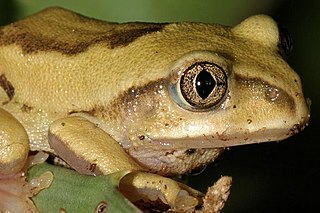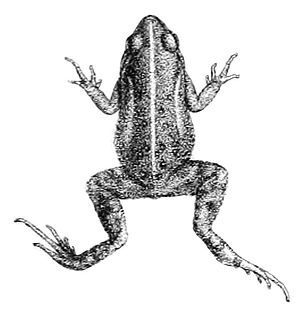Hyperolius mariae is a species of frog in the family Hyperoliidae. It is found in Democratic Republic of the Congo, Kenya, Tanzania, and Zambia. Its natural habitats are dry savanna, moist savanna, subtropical or tropical dry shrubland, subtropical or tropical moist shrubland, subtropical or tropical dry lowland grassland, subtropical or tropical seasonally wet or flooded lowland grassland, rivers, swamps, freshwater lakes, intermittent freshwater lakes, freshwater marshes, intermittent freshwater marshes, arable land, pastureland, rural gardens, urban areas, water storage areas, ponds, open excavations, irrigated land, seasonally flooded agricultural land, and canals and ditches.
Hyperolius pyrrhodictyon is a species of frog in the family Hyperoliidae. It is endemic to Zambia. Its natural habitats are dry savanna, moist savanna, subtropical or tropical dry shrubland, subtropical or tropical moist shrubland, subtropical or tropical dry lowland grassland, subtropical or tropical seasonally wet or flooded lowland grassland, rivers, swamps, freshwater lakes, intermittent freshwater lakes, freshwater marshes, intermittent freshwater marshes, arable land, pastureland, urban areas, heavily degraded former forest, water storage areas, ponds, open excavations, irrigated land, seasonally flooded agricultural land, and canals and ditches.

Hyperolius tuberilinguis is a species of frog in the family Hyperoliidae. It is found in Eswatini, Kenya, Malawi, Mozambique, South Africa, Tanzania, and Zimbabwe.

Leptopelis mossambicus, the brown-backed tree frog, Mozambique tree frog or Mossambique forest treefrog, is a species of frog in the family Arthroleptidae found in Eswatini, Malawi, Mozambique, South Africa, Zimbabwe, and possibly Botswana. Its natural habitats are dry savanna, moist savanna, subtropical or tropical moist shrubland, subtropical or tropical dry lowland grasslands, subtropical or tropical seasonally wet or flooded lowland grasslands, swamps, freshwater marshes, and intermittent freshwater marshes. It is threatened by habitat loss.

The Boettger's dainty frog or common caco is a species of frog in the family Pyxicephalidae. It is found in Botswana, Ethiopia, Kenya, Lesotho, Mozambique, Namibia, Rwanda, South Africa, Eswatini, Tanzania, Zambia, Zimbabwe, possibly Angola, and possibly Uganda. Its natural habitats are dry savanna, moist savanna, subtropical or tropical dry shrubland, subtropical or tropical moist shrubland, subtropical or tropical dry lowland grassland, subtropical or tropical seasonally wet or flooded lowland grassland, subtropical or tropical high-altitude grassland, swampland, intermittent freshwater lakes, intermittent freshwater marshes, arable land, pastureland, plantations, rural gardens, ponds, seasonally flooded agricultural land, and canals and ditches.

The Cape caco or Cape dainty frog is a species of frog in the family Pyxicephalidae. It is endemic to South Africa. Its natural habitats are Mediterranean-type shrubby vegetation, subtropical or tropical dry lowland grassland, freshwater marshes, intermittent freshwater marshes, arable land, pastureland, and canals and ditches. It is threatened by habitat loss.
The Karoo dainty frog is a species of frog in the family Pyxicephalidae. It is endemic to South Africa. Its natural habitats are subtropical or tropical dry shrubland, intermittent rivers, intermittent freshwater marshes, rocky areas, and ponds.
The Katanga caco or Katanga metal frog is a species of frog in the family Pyxicephalidae, endemic to Democratic Republic of the Congo. Its natural habitats are moist savanna, subtropical or tropical seasonally wet or flooded lowland grassland, intermittent rivers, swampland, and intermittent freshwater marshes.

The Namaqua caco or Namaqua dainty frog is a species of frog in the family Pyxicephalidae found in Namibia and South Africa. Its natural habitats are subtropical or tropical dry shrubland, intermittent rivers, intermittent freshwater marshes, freshwater springs, and rocky areas. It is threatened by habitat loss.

The flat caco, flat dainty frog, or smooth dainty frog is a species of frog in the family Pyxicephalidae, endemic to South Africa. Its natural habitats are Mediterranean-type shrubby vegetation, subtropical or tropical seasonally wet or flooded lowland grassland, intermittent rivers, intermittent freshwater marshes, arable land, pastureland, rural gardens, urban areas, ponds, irrigated land, canals and ditches, and introduced vegetation.

Phrynobatrachus mababiensis or the Mababe puddle frog is a species of frog in the family Phrynobatrachidae. It is found in Angola, Botswana, Democratic Republic of the Congo, Kenya, Malawi, Mozambique, Namibia, South Africa, Swaziland, Tanzania, Zambia, Zimbabwe, possibly Ethiopia, possibly Sudan, and possibly Uganda.

The Natal dwarf puddle frog is a species of frog in the family Phrynobatrachidae. It is found in Angola, Benin, Botswana, Burundi, Cameroon, Central African Republic, Republic of the Congo, Democratic Republic of the Congo, Ivory Coast, Eritrea, Ethiopia, Gambia, Ghana, Guinea, Guinea-Bissau, Kenya, Liberia, Malawi, Mali, Mozambique, Namibia, Nigeria, Rwanda, Senegal, Sierra Leone, South Africa, Sudan, Swaziland, Tanzania, Togo, Uganda, Zambia, Zimbabwe, and possibly Burkina Faso, Chad, Lesotho, and Mauritania.

Müller's platanna, also known as Müller's clawed frog, is a species of frog in the family Pipidae found in Angola, Benin, Botswana, Burkina Faso, Cameroon, the Central African Republic, Chad, the Republic of the Congo, the Democratic Republic of the Congo, Ivory Coast, Eswatini, Ghana, Kenya, Malawi, Mozambique, Namibia, Nigeria, South Africa, Sudan, Tanzania, Togo, Uganda, Zambia, and Zimbabwe.
The Kivu clawed frog is a species of frog in the family Pipidae found in the Democratic Republic of the Congo, Rwanda, and Uganda. Its natural habitats are subtropical or tropical moist montane forests, subtropical or tropical high-altitude grassland, rivers, swamps, freshwater lakes, intermittent freshwater lakes, freshwater marshes, intermittent freshwater marshes, arable land, pastureland, rural gardens, water storage areas, ponds, and aquaculture ponds.

Anchieta's ridged frog or plain grass frog is a species of frog in the family Ptychadenidae. It is found in Angola, Botswana, Republic of the Congo, Democratic Republic of the Congo, Djibouti, Eritrea, Ethiopia, Kenya, Malawi, Mozambique, Namibia, Somalia, South Africa, Sudan, Swaziland, Tanzania, Uganda, Zambia, Zimbabwe, possibly Burundi, and possibly Rwanda. Its natural habitats are subtropical or tropical moist lowland forest, subtropical or tropical moist montane forest, dry savanna, moist savanna, subtropical or tropical dry shrubland, subtropical or tropical moist shrubland, subtropical or tropical dry lowland grassland, rivers, intermittent rivers, freshwater lakes, freshwater marshes, intermittent freshwater marshes, hot deserts, arable land, rural gardens, urban areas, and ponds.
Ptychadena cooperi is a species of frog in the family Ptychadenidae. It is endemic to Ethiopia.

The Mascarene grass frog, or Mascarene ridged frog, is a species of frog in the family Ptychadenidae. It is found in sub-Saharan Africa, Madagascar, and Mauritius.
Ptychadena neumanni is a species of frog in the family Ptychadenidae. It is endemic to Ethiopia.

The Schilluk ridged frog is a species of frog in the family Ptychadenidae. It is found in Angola, Burkina Faso, Cameroon, Democratic Republic of the Congo, Egypt, Eritrea, Ethiopia, Ghana, Kenya, Malawi, Mozambique, Senegal, Somalia, Sudan, and Tanzania. Its natural habitats are dry savanna, moist savanna, subtropical or tropical dry shrubland, subtropical or tropical dry lowland grassland, subtropical or tropical seasonally wet or flooded lowland grassland, rivers, freshwater lakes, freshwater marshes, intermittent freshwater marshes, arable land, ponds, seasonally flooded agricultural land, and canals and ditches.

The Natal sand frog is a species of frog in the family Pyxicephalidae. It is found in Mozambique, South Africa, and Eswatini, and possibly Botswana, Lesotho, and Zimbabwe. Its natural habitats are dry savanna, moist savanna, subtropical or tropical moist shrubland, temperate grassland, subtropical or tropical dry lowland grassland, subtropical or tropical high-altitude grassland, rivers, intermittent rivers, swamps, freshwater marshes, intermittent freshwater marshes, arable land, pastureland, and ponds.














